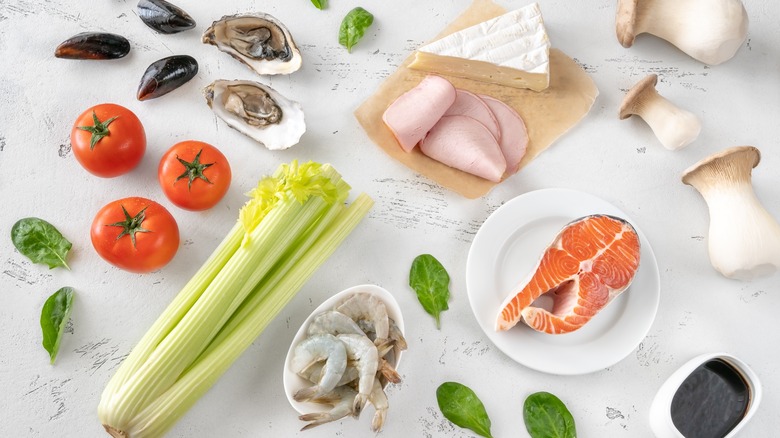Salty Vs. Umami: What's The Difference?
Thousands of taste buds cover our tongues, with anywhere from 50 to 100 taste receptors on each bud, per Harvard University. For a long time, humans were only known to have four taste variations: salty, sweet, sour, and bitter. And before the Greek philosopher Democritus discovered the bitter taste, there were only three, according to NPR. Democritus' theory was that each taste bud has a specific shape, and once the food is chewed, it breaks into pieces that match the taste buds' shape. He claimed the atoms responsible for sweet tastes were round and large, salty atoms were triangular, sour atoms were rough and angular, and bitter atoms were spherical, smooth, and small.
Taste buds weren't truly understood until the 19th century when scientists looked at tongue cells through a microscope; they found taste buds to have keyhole shapes that broadly aligned with Democritus' theory. This was accepted as fact until the late 1800s, when Parisian chef Auguste Escoffier created veal stock and wrote a cookbook detailing how the savory taste of his new stock was unlike any other. Around the same time in Japan, a chemist named Kikunae Ikeda noticed a new taste sensation when he ate dashi, a Japanese seaweed soup. Ikeda found that glutamic acid was responsible for the new taste and noted that it could be found in tomatoes, cheese, meat, asparagus, and more. He called the new taste "umami," which means delicious in Japanese.
Umami has a complex, savory taste sensation
Umami is sometimes hard to pin down, but the Ajinomoto Company describes it as a deep, savory, meaty flavor. As Ikeda discovered, umami is the taste of glutamic acid or glutamate. This compound is even produced naturally in human bodies and can be found in certain food products. To get an understanding of the range of umami flavors, a few examples of food that contain glutamate are asparagus, broccoli, onion, tomato, cheese, chicken, beef, sardine, peas, mushroom, bonito flakes, shitake and porcini mushrooms, shellfish, seaweed, ketchup, truffle oil, miso, ranch dressing, soy sauce, and much more. Monosodium glutamate (MSG) is the distilled, chemical form of umami.
However, many umami foods are also salty, such as cured meats, canned sardines, and soy sauce, so some people find it hard to differentiate between umami and salty. Umami is a complex, long-lasting, balanced taste that causes your mouth and tongue to water. Both salt and MSG can be used as flavor enhancers, however, umami compounds naturally occur in more foods than salt; naturally salty foods seem mostly to come from animal products, like meat and milk (via SFGate). According to Science Focus, adding a little salt cuts the bitterness but enhances the sweet, sour, and umami flavors, while adding a lot of salt tones down sweet tastes and increases umami sensations. Therefore, salty and umami tastes go hand in hand.

